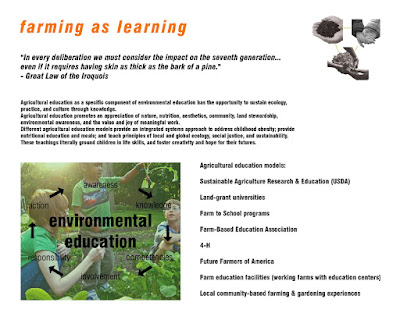
Thursday, October 16, 2008
Thursday, October 9, 2008
Frameworks Presentation
Tuesday, October 7, 2008
Educational institutions are vital labs for creative inquiry, entrepreneurial force and experimentation.
So says, Mariana Amatullo, co-founder and director of Designmatters at Art Center College of Design in a very interesting piece about advocacy design at Core 77. Have a look, if not exactly in line with the work that we are doing, it is quite inspiring.
Monday, October 6, 2008
Sustainability Frameworks
Together the La Flor and Innovation Studios are identifying different mental models for sustainability. Our intention is to use these frameworks to identify different ways of focusing or directing the development of the La Flor campus. While these frameworks are not mutually exclusive, by defining them in opposition to one another we are better able to determine their characteristics and the logical outcomes of their implementation.
Sunday, October 5, 2008
Friday, October 3, 2008
Thursday, October 2, 2008
Arup's Sustainability Practice


Marie Read and xx, of ARUP's sustainability group, shared their approach with the La Flor and the Innovation Studios.
In ARUP's model the integration of ideas, spaces and systems is critical to sustainable practices. The goal of this integration is to reduce the "global footprint" of projects (and ultimately the planet) to ameliorate the growth in the world's resource consumption. In 2004, for example, the World Wildlife Fund estimated that we were exceeding the planet's biological capacity by 20%.
In Arup's practice they seek a level of whole systems thinking to allow the products (both principal products and by products) of one system to be used by another. To accomplish this they focus on several sustainable design principles:
1. Land Use and Transportation -- Aim at creating Community (Healthy, Secure, Engaged)
2. Access & Mobility -- Designing infrastructure to maximize options.
3. Water Resources -- Water Neutral Development.
4. Energy Use -- Reduce Energy Needs on way to trying to achieve energy independence.
5. Materials --Design to reduce material's use throughout the buiilding's life cycle.
6. Waste Management -- Manage and divert waste.
7. Economic & Community Sustainability -- Maintaining economic diversity within communities.
8. Governance & Civic Engagement -- To ensure that long term changes are made.
9. Foresight for Climate Change
10. Habitat Improvement
Working in the developing world, or the global south, is an unusual opportunity as the conditions are often "blank slates" from a planning point of view, and allow for the creation of new economic engines and applicable paradigms for the regions you are working in.
They also shared with us some current masterplanning projects that they are working on.
Wednesday, October 1, 2008
Precedent Research
The examination of precedents is intended to uncover interesting working models, new frameworks for thinking about the project and sometimes random inspiration. The precedents explored here fall into 4 categories: (1) educational models, (2) business plans and facilities, (3) agricultural concepts and practices and (4) environmental designs.
Subscribe to:
Comments (Atom)






















